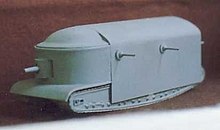Type a search term to find related articles by LIMS subject matter experts gathered from the most trusted and dynamic collaboration tools in the laboratory informatics industry.

A super-heavy tank is any tank that is notably beyond the standard of the class heavy tank in either size or weight relative to contemporary vehicles.
Programs have been initiated on several occasions with the aim of creating an extremely resilient vehicle for penetrating enemy formations without fear of being destroyed in combat; however, only a few examples were built, and there is little evidence of any super-heavy tank having seen combat. Examples were designed in the First and Second World Wars, along with a few during the Cold War.

The first super-heavy tank was designed by the Russian naval engineer Vasily Mendeleyev who worked on the project from 1911 to 1915. The tank was envisioned to be invulnerable to almost all contemporary threats but remained on paper due to its high construction cost.[1][2] Following the production of their first tanks, the British "Flying Elephant" was designed as a tank that would be resistant to artillery fire. Since mobility was more important than protection, and the tanks already developed were successful, work on the project was stopped. The German K-Wagen (Großkampfwagen) was a very heavy design carrying 4 guns and needing a crew of 27. Two of them were under construction when the war ended, and both were demolished.
In the early 1920s, the French produced the 70-tonne Char 2C. The ten tanks would see limited combat during the Battle for France in 1940,[citation needed] but were used mostly for propaganda purposes and the French tried to pull them out of combat zones.
The pre-Second World War design and prototype of TOG2 was heavier than any other contemporary tank used by United Kingdom and can also be considered a super-heavy tank.

During the Second World War, all of the major combatants introduced prototypes for special roles. Adolf Hitler was a proponent of "war winning" weapons and supported projects like the 188 tonne Maus, and even larger 1,000 tonne Landkreuzer P. 1000 Ratte.[citation needed] The British and Soviets all built prototype designs similar to the Jagdtiger, and the US was working on the project then known as T95 Gun Carriage, which was later changed to T28 super-heavy tank. However, not all of these designs were constructed, and most never passed the prototype stage.
Compared to other heavy tanks of the time, the Tiger II can be considered a super-heavy tank, considering that nearly all contemporary heavy tanks in service at the time were significantly lighter.[speculation?] However, during this period of the war Germany generally opted to field and design heavier vehicles. By late 1943, the Panzer IV tank had been significantly up-armed and up-armoured in contrast to its original role and production specifications (resulting in a considerably heavier tank), and Panthers were considered medium tanks despite being of similar mass and volume to contemporary heavy tanks of other nations involved in the conflict. As a result of the trend of generally increasing mass, by late-war German standards the Tiger II is a heavy tank. It is widely classified as a heavy tank by war historians, and nowhere near as heavy as the undisputedly super-heavy Maus.
The idea of very heavy tanks saw less development after the Second World War, not least since the destructive force of tactical nuclear weapons would always overcome any feasible armour. Wartime advances in armour and propulsion technology allowed post-war heavy tanks developed by multiple nations to be significantly heavier than the average heavy tank fielded in World War II, while not reducing overall comparative mobility. Examples include Object 279 (Soviet Union), T30 Heavy Tank (United States) and Conqueror (Britain). All of these vehicles meet or exceed a weight 60 tonnes while still being capable of reaching speeds of 35 kph or faster. While the American T30 tank exceeded 85 tonnes while combat loaded, none of these vehicles can be considered a super-heavy Tank.[citation needed]
Main Battle Tanks were developed and used by every tank building nation during the Cold War, largely phasing out the doctrinal role and use of "Medium", "Heavy", "Cruiser" and "Infantry" tanks. For example, the last heavy tank in American service was the 65-ton M103, which was retired from US Army service in 1963 (and from US Marine service in 1973).[3] Fielding a tank larger than an MBT during this period would not provide a significant advantage to protection or offensive capability, considering the likely battlefield conditions and theaters of war. No super-heavy MBTs were produced during the Cold War.
Further advances in armour technology have given the armour of late 20th century tanks the estimated equivalent of over a metre of rolled homogeneous armour (the primary type of armour used before the invention of composite armour, now used as a standard for comparison between different armour designs). This means adding more armour would not increase protection to any significant degree.[citation needed] Current development is instead focused on a combination of remaining undetected, interfering with tracking, and active countermeasures to neutralize the enemy weapon systems.[citation needed]
Neither of the TOG prototypes were built the way they were designed; had the sponsons been added and the proper turret attached, their weight would have been different.